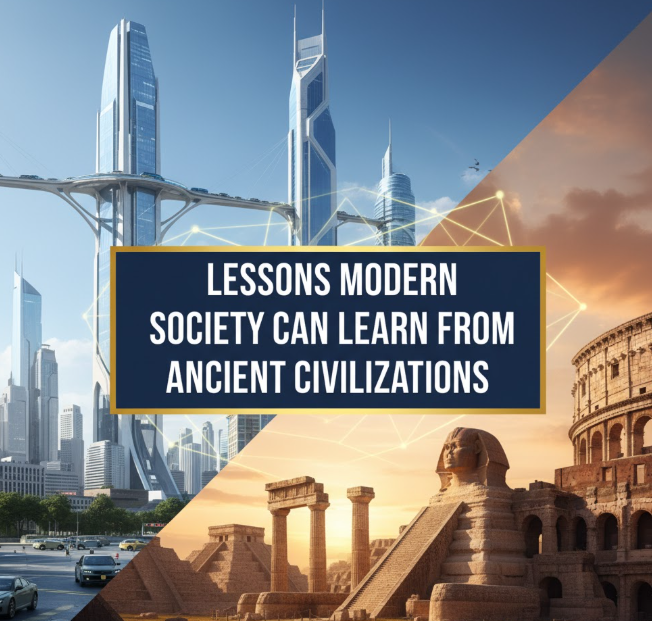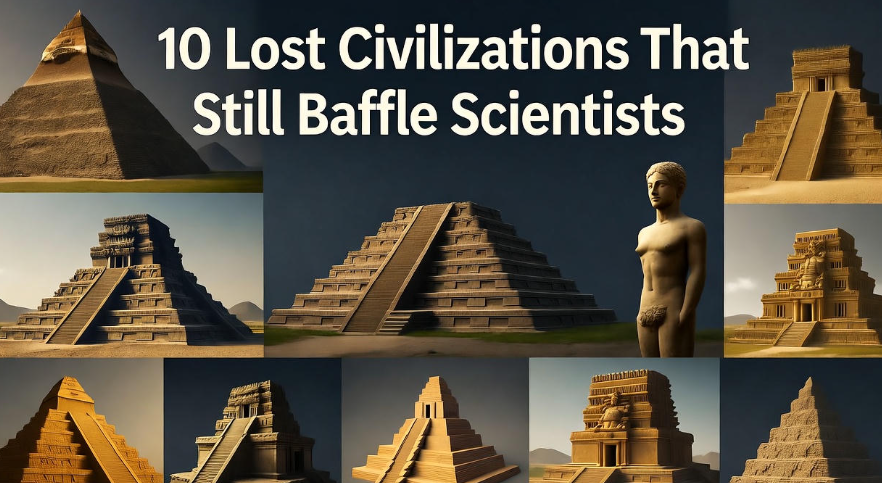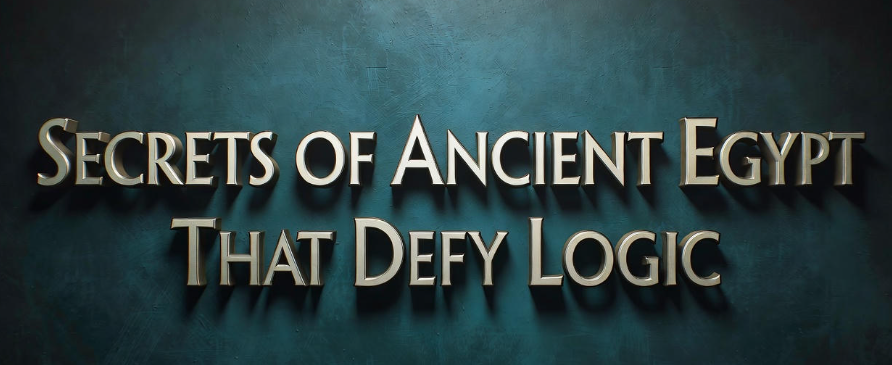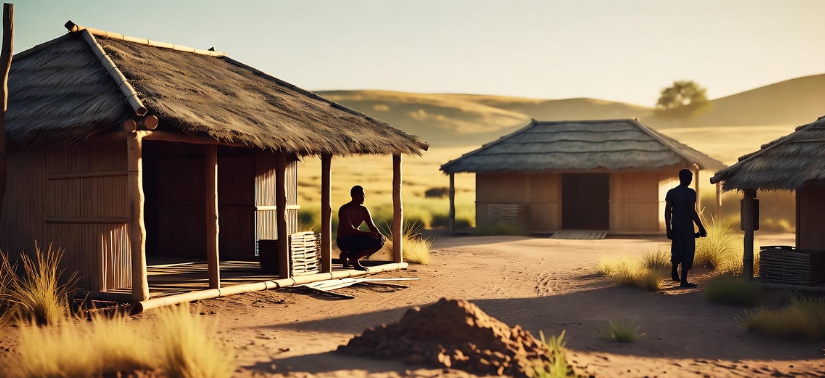It is easy to assume that ancient civilizations were just people who lived a long time ago, with no technology or creature comforts. But in reality, these societies constructed amazing monuments, invented elaborate forms of government and solved problems that we are still dealing with today. The ancient people were quite intelligent and creative, as we all know by their pyramids of Egypt or the aqueducts of Rome. More remarkable, still, is that a lot of their solutions to life’s everyday problems could be exactly what we need in today’s world.
Today, we confront climate change, political alienation and mental health crises and environmental destruction. We have gotten as far as smartphones and artificial intelligence, but we haven’t licked it yet. There were many of the same problems in ancient civilizations — simply manifested differently. They had to develop mechanisms for living in peace and sharing resources, even if that meant coming up with complex social configurations that could last for centuries. But if we look at their triumphs and failures, there are lessons that can be useful for us right now.
Ancient Wisdom, New Science And Why We Still Have To Wash The Dishes
You would be justified in wanting to overturn history, as it feeds racism and hatred. The short answer is pretty simple: human nature hasn’t really changed all that much. Thousands of years ago, people had the same desires we have — to be safe, happy, to belong and to find meaning. They simply took different paths to achieve these goals. Ancient societies had to improvise, since they didn’t have technology to solve every problem. This compelled them to create smart systems, strong values and sustainable practices that allowed their civilizations to flourish for generations.
Our world is moving at such a fast pace. We can send a message to someone on the other side of the planet in an instant, but we frequently feel disconnected from our neighbors. We have more choices of what to eat, but so many people are unhealthy. Medically speaking, we are more advanced than ever before — and yet our stress and anxiety levels hit all-time highs. The great civilizations of the past remind us that less technology wasn’t necessarily synonymous with less wisdom. Their solutions, in fact, tended to be more holistic and forward-looking with respect to the whole community and future generations.
Building Communities That Actually Care
The Social Power Of The Ancient Greek Bond
There was something ancient Greeks understood about humans that we have forgotten: Humans need real human connection. They didn’t have social media but built stronger communities than any we know. City-states in ancient Greece such as Athens made public areas available where people assembled to chat, debate and practice democracy — these open markets were called agoras. Neighbors knew one another and community decisions were made collectively.
Contrast that with today when we can have hundreds of “friends” online yet be lonely in a crowd. Research also indicates that loneliness is a serious health problem, leading some experts to say it can be as dangerous as smoking 15 cigarettes a day. The Greeks remind us that community is not only a luxury but necessary for our well-being. They invested in relationships that were direct and face-to-face, creating spaces where people gathered together out of natural rhythms.
Roman Emphasis on Civic Duty
Romans took community responsibility seriously. Most Australians believed that to be a good citizen, one had to do more than simply obey laws – being supportive of society or taking an active part in it were also vital qualities. Public buildings, roads and entertainment that everyone would enjoy was paid for by rich Romans. It didn’t have to be done, it was an expectation of being a respected member of the community. They called this “noblesse oblige,” the concept that with their privilege came responsibility.
Rights are often more in our conscience than responsibilities are today. We demand freedom without realizing that freedom operates best when everyone is also thinking of their duty to others. The Roman model emerges of a dynamic in which wealthy people identify and become identified with the common good, not only by paying taxes (that’s something they always did) but through practical benefaction (a polite way to describe philanthropy as we know it today).
Environmental Lessons from Indigenous Peoples
The Iroquois Seven Generation Principle
The Iroquois Confederacy, a coalition of Native American tribes, had a straightforward but affecting rule: every decision should reflect the needs of the next seven generations. Which is to say, 140 years from now! They asked themselves: “Will our great-great-great-great-great-grandchildren thank us for this decision?”
This principle is totally the opposite of how we are currently working. Modern politics tends to look to the next election cycle — four years down the road, perhaps. Corporations think about quarterly earnings — at most, three months ahead. We use a plastic that takes hundreds of years to disintegrate for products we take minutes to use. The Iroquois rule is a reminder that wisdom entails reflecting on the downstream effects of our acts.
Incan Agricultural Innovation
The Inca civilization thrived on the harsh terrains of the Andes Mountains, so they had to work in harmony with nature rather than trying to overpower it. They built steep hillside terraced farms that mitigated erosion and efficiently trapped water. They rotated crops and grew a variety of plants together, which maintained the soil health without chemicals.
Modern industrial farming tends to do the opposite. We plant mono-crops across massive expanse, sucking the soil of its nutrients and demanding chemical fertilizers. We are now learning the hard way that the Incan alternative was smarter — sustainable farming that could be passed down through generations without wearing out or wrecking the land.
| Ancient Practice | Modern Problem It Solves |
|---|---|
| Crop rotation and diversity | Soil depletion, chemical dependence |
| Terraced farming | Erosion, water waste |
| Community land management | Corporate food monopolies |
| Seed saving and sharing | Loss of plant varieties |
Economic Systems with Heart
Babylonian Fair Trade Standards
One of the earliest legal codes was established by ancient Babylon, detailed in the Code of Hammurabi, which included laws for fair business practices. Merchants could not steal from customers, contracts had to be upheld and there were protections for the vulnerable. If you borrowed money, there were ceilings on how much interest lenders could charge. These laws understood that a well-functioning economy depends on trust and fairness, not just the profit motive.
Today we’re fighting income inequality, predatory lending and corporate practices focused less on stakeholders than shareholders. The Babylonian method is a reminder that economies function better when ordinary people have strong protections and profit isn’t the sole consideration.
Gift Economies of Polynesian Cultures
Many Pacific Island cultures followed what anthropologists call “gift economies.” Instead of using money for everything, people would give selflessly to others with the knowledge that the community would in turn support them when they required assistance. That created strong social bonds and that everyone’s basic needs were met. You were not wealthy by how much you got but rather by how much you gave away.
We can’t ditch money altogether, but this principle applies to contemporary life. It’s the same concept as community-supported agriculture (CSAs), tool libraries and neighbor helping networks—share what you’ve got and help out in return. These systems generate resilience and a sense of connection that pure market economies can’t.
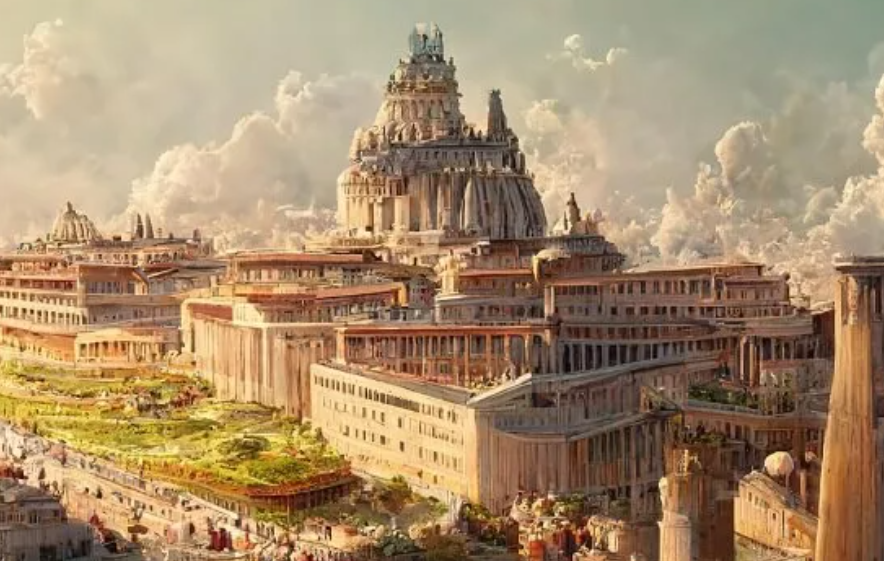
Medical Care for the Whole Person
Ancient Chinese Holistic Medicine
Traditional Chinese medicine, which was developed thousands of years ago, treated the entire person —body mind and spirit—rather than just symptoms. Physicians emphasized prevention of sickness through a healthy diet and exercise, stress management, balance in life. The priority here was health, not just treatment of sickness. Chinese doctors even got paid when they kept their patients healthy — not when they made them sick!
Western medicine is very good at addressing acute problems — broken bones, infections, emergency surgery. But we die of chronic diseases that result from lifestyle — heart disease, diabetes, depression. The Chinese strategy is a reminder that being smarter about headlong development and growth, rather than just treating the consequences of it when they emerge, is better preventing problems. It demonstrates that mental and physical health are profoundly intertwined, which is something we are only now learning once again through research.
-
🌍 Read more: 10 Incredible Facts About Early Human Ancestors
Egyptian Dentistry and Public Health
The Ancient Egyptians were among the first to practice medical care and personal hygiene. They made some of the first toothbrushes and toothpaste, recognizing that oral health was linked to overall health. They even had principles of public health, such as rules for preparation of foods and codes of cleanliness. These Egyptian physicians were trained in various specialties and maintained rigorous medical records.
The obsession of the Egyptians with prevention and hygiene was quite appropriate during recent pandemics. Their understanding that public health depends on community-level standards and practices, not just personal care is a lesson we repeatedly seem to forget.
Educational Philosophy Worth Reviving
Greek Emphasis on Critical Thinking
The ancient Greeks were not merely memorizing knowledge — they learned to question everything. Socrates was legendary for strolling around Athens pressuring people to defend their beliefs, and discovered that many of the most widely shared assumptions collapsed under scrutiny. Greek education was about reasoning, rhetoric and philosophy. Your students were challenged to argue both sides of an issue so they could really understand the point of complex issues.
Modern education tends to focus on standardized tests and facts that must be memorized. Facts do matter, but the Greek model of education could be one that teaches students how to think rather than what to think. In this era of misinformation and polarization, having the ability to think critically is more important than ever.
Apprenticeship Models Across Cultures
Until formal schools came into being, apprenticeship was the prevalent mode of education — kids learned on the job from masters immersed in daily life. Whether it was blacksmithing during medieval Europe, pottery during ancient China or weaving in pre-Columbian Americas, this hands-on learning fostered deep expertise and allowed knowledge to be communicated directly across generations.
And now, we are relearning that some things you learn best by doing, not just by studying. The principles of apprenticeship are applied in medical residencies, coding bootcamps and vocational schools. Ancient pedagogy tells us that education is not just the imparting of knowledge but developing uprightness and the ability to go out in the street and know how to comport exactly.
Governance and Justice Systems
Athenian Direct Democracy Experiments
Athens wasn’t perfect (women and enslaved people were barred from participating), but they set the model for the idea that ordinary citizens could govern themselves, a nation of laws not men. Athenians voted directly on laws and policies, sat on juries, and could hold officials to account. Many public offices were not elected, but filled by a drawing; and all this on the expectation that most of the citizens would be employed in conducting the government.
Today, representative democracy often seems removed from the lives of ordinary citizens. Many citizens believe their votes are immaterial and politicians don’t serve their interests. The Athenian example implies that greater people power — through local decision-making, citizens’ assemblies and participatory budgeting — would lead to stronger democracy.
Restorative Justice in Indigenous Societies
Many first peoples still practiced what we have come to call restorative justice. When a crime was committed, the emphasis wasn’t just on punishment but also on recovery of the harm caused to victims and reintegration of the offender into society. The process included conversation, accountability and restitution.
Our contemporary justice system is fixated on punishment and incarceration, a misguided approach that causes as many problems as it solves. Prisons are bursting at the seams, repeat-offender rates are high, and victims frequently feel forgotten. The age-old healing touch provides an alternative that focuses on cure and reformation, instead of retribution.
Work-Life Balance Before It Was Cool
Roman Bath Culture and Leisure
Romans were diligent workers, but they also knew the value of rest and relaxation. Public baths weren’t simply places to scrub up; they were hubs of social activity, where people relaxed in warm water and got a massage, exercised and even strolled around with friends. Romans celebrated many other festivals and holidays too. They understood that leisure was also necessary for health and happiness.
Today, burnout is an epidemic. We put in longer hours than medieval peasants once did, and we have work on our mind all the time. The Roman model suggests that even industrious societies allow for leisure. And, in fact, the sense of good rest makes people more productive, not less.
Guild Regulations for Work in the Middle Ages
There were in fact rules in medieval craft guilds that limited the hours people could work each day and banned nighttime or Sunday labor. These weren’t simply labor protections — guild masters believed that tired workers built shoddy products. The system had cultivated a form of efficiency that was productivity with well-being.
The gig economy and “hustle culture” of today preach to us that the only way to succeed is to be working all the time. But a medieval vision of work holds that limits produce better outcomes — more quality, innovation and healthier people.
Architecture and Urban Planning
Persian Windcatchers for Cool Air
Ancient Persians created wind towers (badgirs) that caught hot breezes and directed cool air into buildings, providing natural air conditioning in the deserts. These towers functioned without electricity, relying on physics to efficiently cool buildings all the way through extreme heat.
As temperatures rise in response to climate change and energy prices go up, we’re discovering that old cooling techniques can also be very efficient. Current architects are using natural ventilation, thermal mass, and similar passive cooling methods which the ancients knew inherently.
Roman Road Engineering
Roman roads were also so well made that some are still in use today, 2,000 years after they were first built. The surface was prepared, multiple layers of materials used, drainage included and proper foundations laid. This took more energy and resources in the beginning, but what resulted were roads that lasted for thousands of years with little maintenance.
Today’s infrastructure is frequently built cheap and fast, resulting in roads that require regular repair. The Roman principle — invest in doing things right the first time — is actually cost-effective and resource-saving down the line.
| Ancient Innovation | Modern Equivalent | Benefit |
|---|---|---|
| Roman aqueducts | City water distribution systems | Clean water availability for all |
| Aqueduct arches | Dam technology and bridges | Disaster resiliency, connecting people |
| Wind mills (for grain) | Wind power | Farms savings, sustainable agriculture |
| Mayan reservoirs | Catchment basins | Resilience in the face of drought |
| Pythagorean mathematics | Connectedness among ideas | Usability of a wide range of phenomena toward explaining patterns/future occurrences |
Conflict Resolution and Diplomacy
Persian Communication Networks
The empire was made up of many lands with diverse cultures and languages. Rather than imposing uniformity, Persian rulers allowed local customs and religions to be maintained and established an impressive communication system. They constructed roads, set up courier systems and wrote official documents in several languages. This tolerance and exchange preserved peace in widely scattered regions.
This is the same dilemma facing our globalized world – how can we hold ourselves together while embracing diversity? We are in the midst of a conflict that is best navigated by identifying difference and creating ways of communicating and understanding between these differences, rather than imposing uniformity. The Persian example teaches us to make space for recognizing differences while creating channels for communication and understanding on terms not forced but negotiated.
Native American Council Traditions
Many Native American tribes decided things in council process when elders or leaders would listen to everyone. The practice was similar to the talking stick, where only whoever held the stick could speak, while the others listened, to allow all voices — even silent ones — to be heard. Decisions were not hurried; councils went on until consensus was achieved.
Meetings and political debates in the modern world are dominated by people talking over each other as they attempt to win arguments rather than arrive at solutions. The tradition of council offers us a reminder that good decisions require the real listening that occurs only when we slow down and turn to those who may have very different views, and that consensus is often stronger — and certainly more lasting — when we take time to arrive at it.
Spiritual and Mental Health Practices
Buddhist Mindfulness Techniques
2,500 years ago, Buddhist monks created meditation practices to induce a state of mental clarity and suppress suffering. They got that their pain most often came from being caught up in thinking about the past or future, and not living in the present. They are thousands of years old, and there has been plenty of time to hone them.
Contemporary psychological and neuroscientific research has proved what Buddhists have known for more than 2,000 years — mindfulness meditation is good for the body, mind and soul! Secular mindfulness trainings are now being used in schools, hospitals and businesses across the globe. For more information on the science behind mindfulness and meditation, numerous studies have documented its benefits.
Greek Philosophical Therapy
The ancient Greek philosophers, from the Stoics onward, developed techniques to control emotions and find tranquility in challenging situations. They reminded us that we can’t control events, but we can control how we react to them. By concentrating on what is within our power and recognizing what isn’t, we can find tranquility even in challenging circumstances.
Contemporary cognitive-behavioral therapy (CBT), one of the most successful psychological interventions, is founded squarely on Stoic concepts. Because, before modern psychology was a thing, the ancient Greeks more or less invented therapy and understood that philosophy isn’t just abstract philosophizing — it’s practical wisdom for living.
Food and Agriculture Wisdom
Mediterranean Diet Origins
The classic Mediterranean diet — rich in vegetables, fruits, whole grains, legumes and olive oil, with moderate fish and low dairy intake but minimum meat consumption — wasn’t developed by nutritionists. It developed over thousands of years in Greece, Italy and the like, regions where what grows well locally — a wide variety of fruits and vegetables (hence, produce), beans and grains — was what kept people healthy.
Studies back up the notion that this ancient diet is among the healthiest on earth — it reduces heart disease and diabetes, and may extend lifespan. Meanwhile, modern processed foods — formulated in laboratories to be easy and profitable rather than healthful — are making us overweight and sick. The example of the Mediterranean, proves to me again and again that traditional diets (if they are indeed rooted ones developed through generations of experience), often win over the most scientifically engineered foods.
Japanese Eating Mix with Japanese Choices and Serving Size Control
This is consistent with traditional Japanese culture which encourages diners to stop when 80% full (hara hachi bu) and serve food elegantly in smaller portions. Meals are viewed as aesthetic and social experiences, not merely fuel. It raises awareness of eating and natural portion control.
Modern Western culture on the other hand often advocates for eating quickly, huge portion sizes and rolling out food engineered to be addictive. The Japanese way calls for a healthier relationship with food that stops you from eating more than you should without starving yourself.
Ancient Wisdom in Everyday Life
So, how do we actually use these ancient instructions to live in the modern world? It begins with an acknowledgment that newer isn’t necessarily better. Here are some practical ways to integrate this ancient wisdom:
Start Small: You don’t have to completely transform your life overnight. Choose one old principle that rings true for you. Perhaps it’s something along the lines of Iroquois seven-generation thinking in our consumption behavior, or ancient Greek consideration of “what would I want my children to think about this?”
Make Modern Forms of the Old Ways: Ancient practices that work for modern life. You can’t create an agora in your neighborhood, but you could establish a regular block party or coffee klatch. You may not become a Stoic philosopher, but you can commit to five minutes of mindfulness daily.
Question Modern Assumptions: Old wisdom invites us to ask whether the way we do things now are really in our service. Must we be working 60 hours a week? And does scrolling through social media actually bring us together? Would we be healthier if we ate more like our ancestors?
Pass Down Knowledge: History’s original knowledge management system was oral tradition and apprenticeship. Chat to elders in your community, exchange skills with your neighbor, teach children practical wisdom as well as academic subjects.
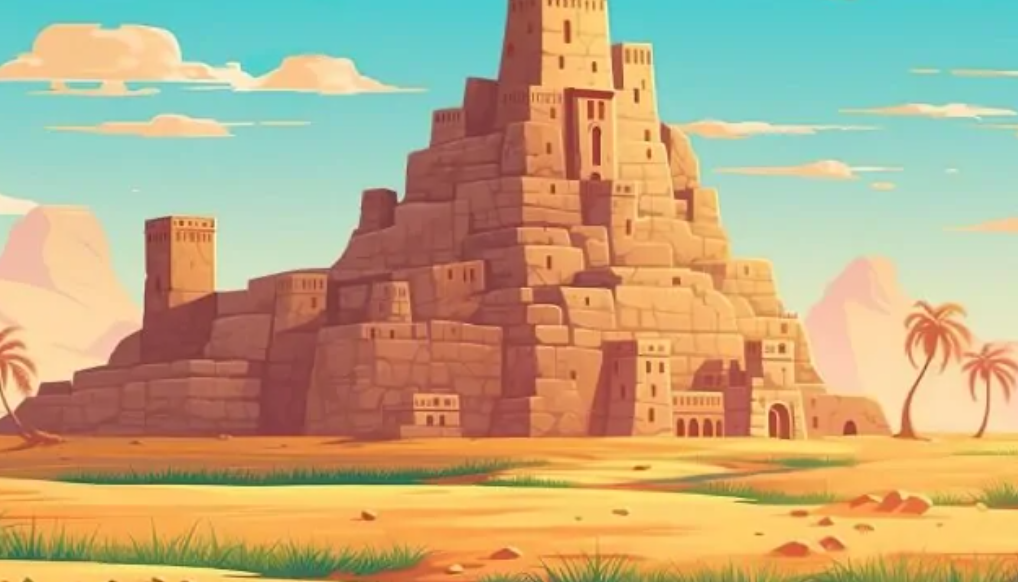
Frequently Asked Questions
Q: But weren’t the civilizations of old full of stuff like slavery and inequality?
A: Absolutely. Old societies were deeply flawed, and we shouldn’t romanticize them or wish for a full return to the past. We’re not trying to reproduce ancient societies, of course: We want to learn from both the mistakes and triumphs of the past. To this we can add their sustainable ways of living and sense of community, while retaining the progress in human rights and equality that has flowed under the bridge since those days.
Q: How can we apply ancient wisdom in the midst of totally new challenges such as climate change and artificial intelligence?
A: Though the specific problems may be novel, the underlying challenges — how to think long-term, how to balance progress with sustainability, how to hold on to human values as change transforms us — are age-old. Old principles, such as seven-generation thinking and holistic problem-solving can inform how we face novel circumstances.
Q: But is it a waste of time to rely on old-fashioned techniques, when technology has advanced so far?
A: Sometimes, yes. We should not abandon modern medicine or electricity. But technology is not always more efficient — Roman concrete outlasts our own, Persian cooling systems require no electricity and direct democracy on local issues can be more nimble than bureaucracy. The trick is wielding ancient wisdom and modern tools judiciously.
Q: What ancient civilization had the most to teach modern society?
A: Each culture was superior in a different dimension. The Greeks in philosophy and critical thought, the Romans in engineering and civic duty, Aboriginal people in environmental sustainability, Eastern cultures in holistic health. We can learn from each of them.
Q: What are some good ways to learn about ancient civilizations and their customs?
A: Begin with history books that are within reach, along with documentaries and trips to museums. There are a number of free online courses on ancient history offered by many universities. You can even experiment with living traditions—many indigenous practices or traditional medicine and philosophies have lived on to this day, and anyone who comes to them in respect will often be given a warm welcome as a learner.
Q: Can the wisdom of the ancients really address modern problems, or is this simply nostalgia?
A: Not ancient wisdom being able to solve everything, but recognizing that people across history faced some of the same fundamental challenges. Their solutions endured through centuries; many modern systems are just decades old. The wisdom of the ages can be very valuable when used in concert with modern wisdom.
The Path Forward: Mixing Old With New
The more exciting possibility is not picking between ancient wisdom and modern innovation — it’s synthesizing them. We can use modern technology to deploy ancient principles at larger scales. Just imagine urban planning that takes green spaces into account, in the same way ancient cities did before them, but with modern materials and techniques. Or social media platforms built around real connection, not addiction — using ancient knowledge about human needs to advance new technology.
And time-jaunting specimens of ancient civilization can teach us that human beings have always been inventive, smart and able to work their way through difficult answers. They demonstrate that sustainable, satisfying societies do not have to do so in a way which uses up the planet’s resources or damages human welfare. And most crucially, they demonstrate that wisdom derives not from possessing the most recent technology — it comes from knowing what really matters for human flourishing.
As we grapple with new, unprecedented challenges in the 21st century, we don’t have to reinvent the wheel. Thousands of years of human experience provide a series of tested solutions. The issue isn’t that ancient wisdom is irrelevant. It’s whether we are wise enough to learn from it. Our forefathers passed on to us more than monuments and relics; they gave us the tools, in their own example, to construct enduring civilizations and powerful civic communities that outlive eras of history.
The future need not be amnesiac about the past. The best course for the future might just be one that looks both ways — valuing traditional wisdom and embracing the potential of new ideas. By doing so, we create something that is neither simply ancient nor only modern but truly timeless: a society that builds upon the past while looking forward to a more hopeful future.

